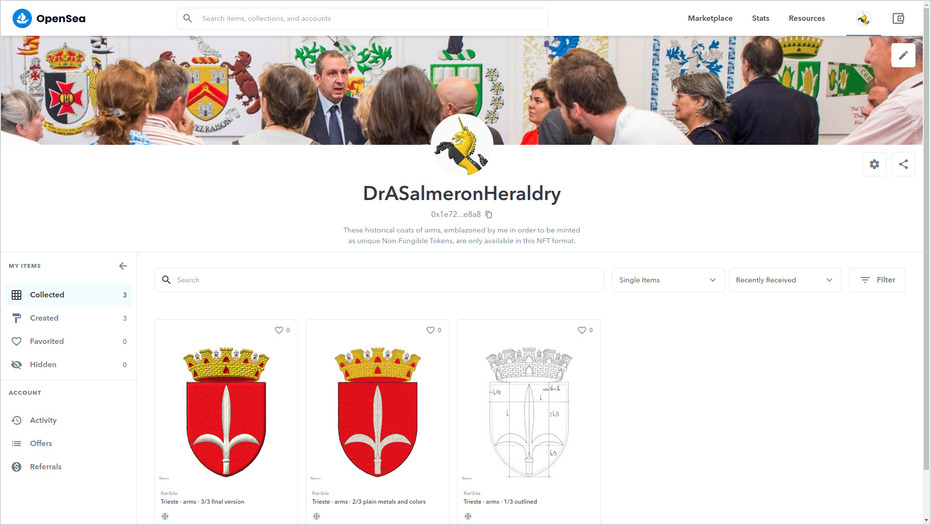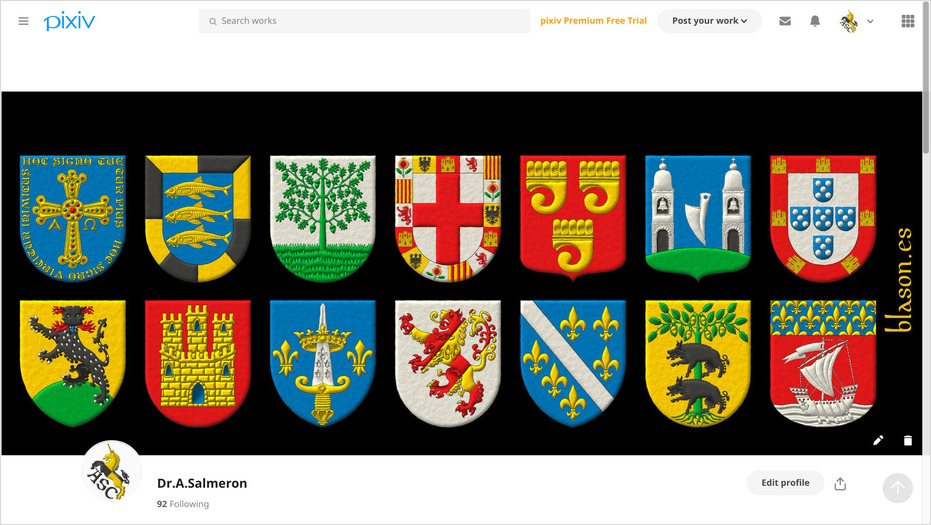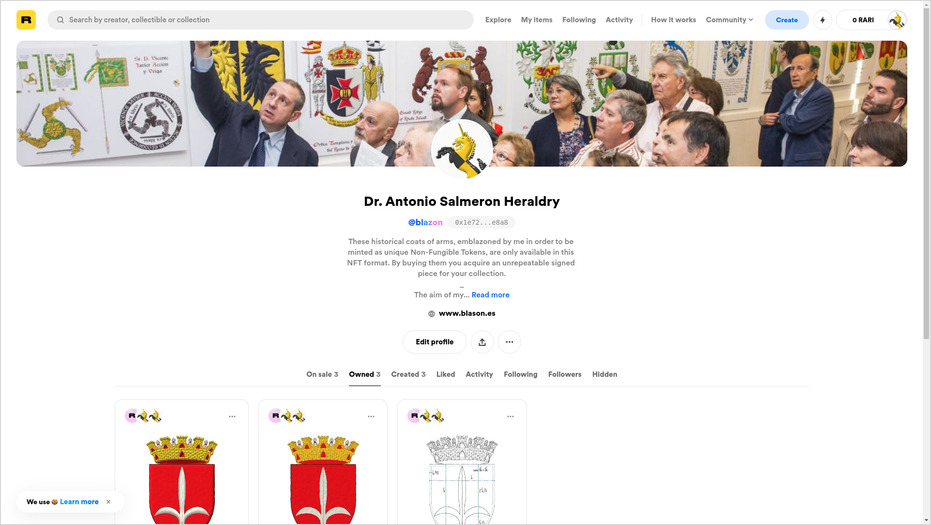Issuant from base


Albrecht Dürer
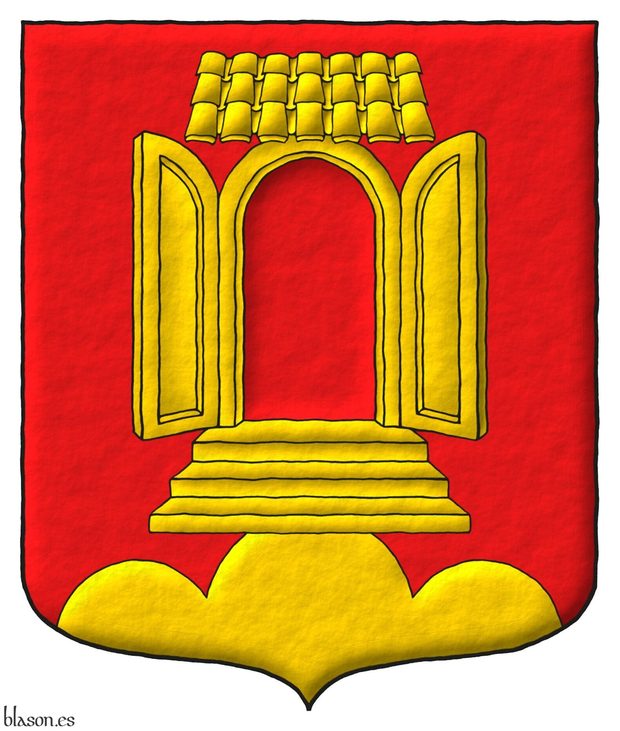
Gules, on a trimount issuant from the base Or, a port Gules, with canopy roof, jambs, enarched lintel, and two open leaves, upon a three-step stairway Oro.
Escudo de gules, un monte de tres peñas moviente de la punta sumado de una puerta con tejadillo, jambas, dintel arqueado, dos hojas abiertas sostenida de una escalinata de tres peldaños todo de oro, aclarada de gules.
Coat of arms painted by me, illuminated with lights and shadows, outlined in Sable, with an ogee external shape and with a freehand finish.
Coat of arms of Albrecht Dürer, 1471-1528, emblazoned by me based on the woodcut titled «Coat of Arms of Albrecht Dürer» made by Albrecht Dürer himself in 1523 on a sheet measuring 35.1 × 26.1 cm belonging to The Elisha Whittelsey Collection, The Elisha Whittelsey Fund, 1952, held at the Metropolitan Museum of New York, and on the work titled «Marriage Coat of Arms of the Families Duerer and Holper. Verso of the Albrecht Dürer the Elder portrait», dated 1490; Albrecht Dürer the Elder, 1427–1502, was his father.
Design rationale
The Dürer family coat of arms is an example of canting arms. Their family origin traces back to Ajtós, Hungary, a name which means «door» or «doorman» in Hungarian. Upon settling in Nuremberg, the family Germanized their surname to «Türer», derived from «Tür», meaning «door», and later to Dürer. This is the reason of the main charge of these arms.
Blazon keywords: Gules, One, Two, Three, On, Trimount, Issuant from base, Port, Canopy roof, Arched, Enarched, Upon, Step, Stairway and Port and windows.
Style keywords: Outlined in sable, Illuminated, Ogee and Freehand.
Classification: Personal, Lineage, Interpreted, Boa and Coat of arms.
Bearer: Albrecht Dürer.


Amitay Edward von Stiebel, outlined
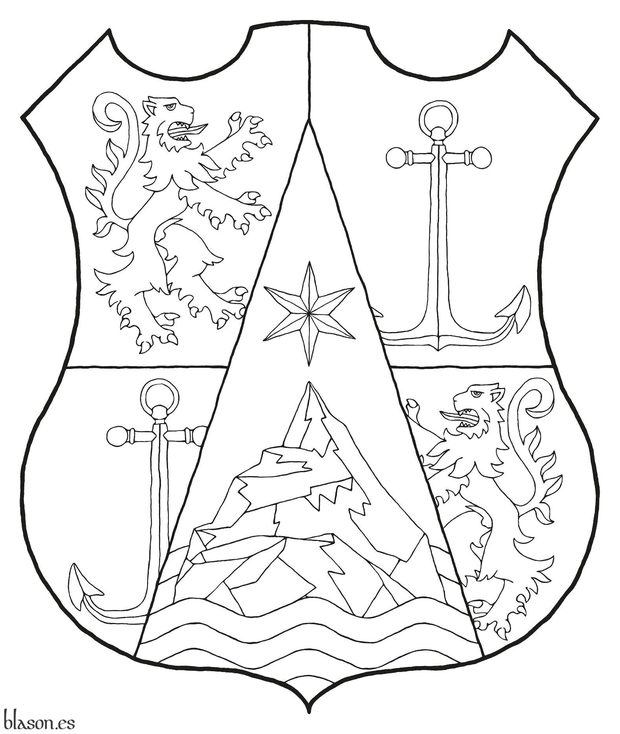
Quarterly: 1 Or, a lion rampant, facing sinister Sable, armed and langued Gules; 2 and 3 Gules, an anchor proper; 4 Or, a lion rampant Sable, armed and langued Gules; overall, a pile issuant from base Azure charged with a mount proper issuant from water issuant from base Argent, in chief, a mullet of six points Or.
Coat of arms of Amitay Edward von Stiebel outlined by me.
Blazon keywords: Or, Sable, Gules, Azure, Argent, One, Six, Quarterly, Lion, Rampant, Facing sinister, Armed, Langued, Anchor, Proper, Overall, Pile issuant from base, Charged, Mount, Issuant, Water, Issuant from base, In chief and Mullet.
Style keywords: Outlined and Bull's hide.
Classification: Personal, Interpreted, Boa and Coat of arms.
Bearer: Stiebel, Amitay Edward von.


Arturo Taborda
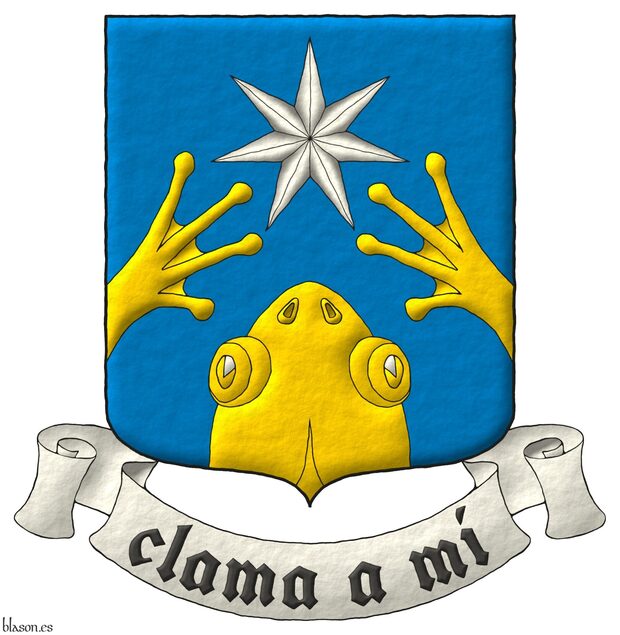
Azure, issuant from base a frog's head and from flanks its forelegs in chevron Or, in chief a mullet of seven points Argent. Motto: «Clama a mí».
Escudo de azur, moviente de la punta una cabeza de rana y de los flancos sus patas delanteras en chevron todo de oro, en jefe una estrella de siete puntas de plata. Lema: «Clama a mí».
Coat of arms emblazoned by me, illuminated with lights and shadows, contoured in Sable, with an ogee outer contour and with a freehand finishing.
Coat of arms of Arturo Taborda, Venezuela, emblazoned by me. The motto came from Jeremiah 33:3 «Clama ad me, et exaudiam te, et annuntiabo tibi grandia et firma quæ nescis» ~ «Call to me, and I will answer you, and show you great and mighty things, which you do not know».
Blazon keywords: Azure, Or, Argent, One, Seven, Issuant from base, Frog, Head, Flank, Foreleg, In chevron, In chief, Mullet and Motto.
Style keywords: Outlined in sable, Illuminated, Ogee and Freehand.
Classification: Personal, Interpreted, Boa and Coat of arms.
Bearer: Taborda, Arturo.


Barrio Alto of Mon'Tarena
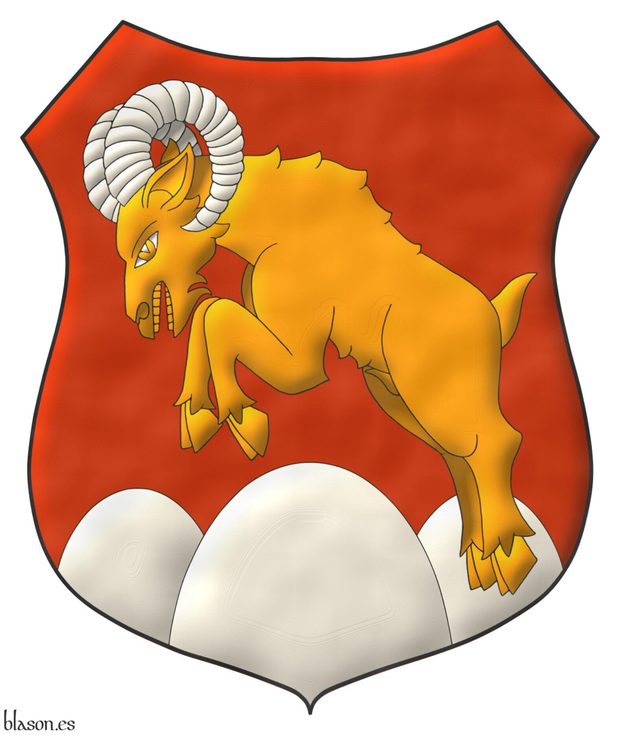
Gules, on a trimount issuant from the base Argent a bighorn sheep salient Or, horned Argent.
Escudo de gules, un monte de tres peñas moviente de la punta de plata sumado de un borrego cimarrón saltante de oro, acornado de plata.
Coat of arms designed by me, highlighted with lights and shadows, contoured in Sable, with a chasuble external shape and with a watercolor finish.
The coat of arms of the Barrio Alto of Mon'Tarena, Queretaro, Mexico, designed by Joaquin Haces Perdomo and me and emblazoned by me. The bighorn sheep is a symbol of strength and is native to the mountains of northern Mexico. Males, like the one depicted in this coat of arms, can weigh up to 300 lbs and are known for their impressive curved horns.
Blazon keywords: Gules, Or, Argent, One, On, Trimount, Issuant from base, Bighorn sheep, Salient and Horned.
Style keywords: Outlined in sable, Illuminated, Chasuble and Watercolor.
Classification: Civic, Created, Boa and Coat of arms.
Bearer: Barrio Alto of Mon'Tarena.


Crest, mantling and motto of Marcio Vieira Nastri
Tierced per fess: 1 Sable, seven mullets Argent arranged as the Plough of Ursa Major; 2 Azure; 3 Sanguine, a demi-sun issuant from base Or. Crest: Upon a helm with a wreath Or and Sanguine, a raven proper. Mantling: Sanguine doubled Or. Motto: «Incipit Vita Nova» Or, over a scroll Sanguine doubled Or.
Coat of arms interpreted by me, highlighted with lights and shadows, outlined in Sable, with an ogee outer contour and with a leather finishing.
Design rationale
The arms symbolise the dawn of a new life. The field is tierced per fess to evoke the sky in 3 stages: Sable for the darkness of night, Azure for the horizon at first light, and Sanguine for the rising sun. The 7 stars of Ursa Major, in their traditional arrangement, evoke guidance, constancy, and a Dantesque reference, as the constellation appears in the Divine Comedy. The demi-sun in base, gold upon sanguine, marks the moment of emotional awakening, the dawn of love. The scroll motto «Incipit Vita Nova», the first line of Dante’s Vita Nuova, reflects a personal spiritual transformation. The Azure speaks of eternal loyalty, and the silver stars of purity. The choice of Sanguine, both for the sunlit sky and for the scroll and mantling, is also an homage to Beatrice’s dress as described by Dante at their first encounter. All of the above holds a parallel with the bearer’s personal life, which gives this composition a dual significance, both literary and deeply intimate. The raven as crest, a symbol of memory and intelligence, represents the collector’s spirit and a deep inner life.
Blazon keywords: Sable, Azure, Sanguine, Argent, Or, Seven, One, Tierced per fess, Mullet, Plough of Ursa Major, Demi, Sun, Issuant from base, Crest, Upon (wreath), Helm, Wreath, Raven, Proper, Mantling, Motto and Scroll.
Style keywords: Outlined in sable, Illuminated, Ogee and Leather.
Classification: Personal, Interpreted, Design rationale, Boa and Coat of arms.
Bearer: Nastri, Marcio Vieira.


Graaf, Jay Geoffrey De
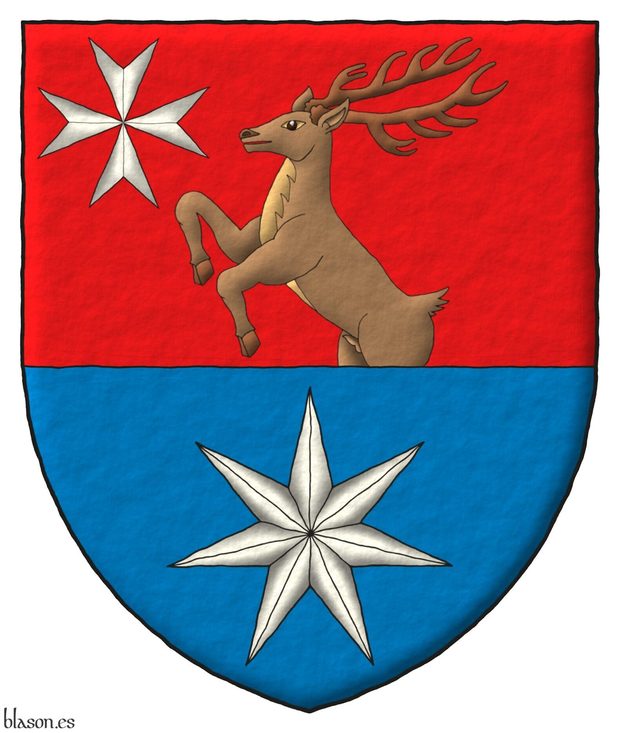
Party per fess, 1 Gules, a stag rampant, issuant from base proper, in the dexter chief a Maltese cross Argent; 2 Azure, a mullet of seven points Argent.
Escudo cortado: 1o de Gules, un ciervo rampante, moviente de la punta al natural, en la diestra del jefe, una cruz de Malta de plata; 2o de azur, una estrella de siete puntas de plata.
Coat of arms emblazoned by me, illuminated with lights and shadows, contoured in Sable, with a pointed outer contour and with a freehand finishing.
G0131, augmentation of G0042, Chief Herald of Arms of Malta's grant of the coat of arms of Jay Geoffrey De Graaf, Australia. The augmentation consists of the addition of a Maltese cross Argent in the dexter chief. This coat of arms has been emblazoned by me.
Blazon keywords: Gules, Azure, Argent, One, Party per fess, Stag, Rampant, Issuant from base, Proper, In the dexter chief, Eight-pointed cross, Cross couped and Mullet.
Style keywords: Outlined in sable, Illuminated, Pointed and Freehand.
Classification: Personal, Interpreted, Boa and Coat of arms.
Bearer: Graaf, Jay Geoffrey De.


Ignasi Pujol, comparation
[ Azure, a mount issuant from the base, in chief a fleur the lis Argent ] and [ Party per chevron Azure and Or, in chief a fleur de lis Argent, in base four pallets Gules ].
The coat of arms of Ignasi Pujol was designed by him based on the ancient arms of the Pujol lineage, 1st image, and refined and emblazoned by me, 2nd image. The comparison of the blazon of the Pujol lineage with the blazon for Ignasi Pujol is the following.
Blazon keywords: Azure, Argent, Or, Gules, One, Mount, Issuant from base, In chief, Party per chevron, Fleur de lis, In base, Pallet and Pale.
Style keywords: Outlined in sable and Illuminated.
Classification: Lineage, Personal, Compare, Interpreted, Coat of arms and Boa.
Bearer: Pujol, Ignasi.


Motto around the shield of Alejandra Espeja Avieda

Or, four bell towers issuant from base Gules, windows Or. Motto around the shield: «Linaje Lanzagorta Otxoa · Catalunya · Barcelona» Sable over a scroll Argent.
Coat of arms painted by me, in plain tinctures, contoured in Sable, with a semi-circular external shape and with a texturized finishing.
Coat of arms of Alejandra Espeja Avieda, familiarly known as Sandra. This shield, surrounded by an annular scroll Argent inscribed in sable, has been designed byhas been designed by Juan Lanzagorta Vallín and emblazoned by me.
Blazon keywords: Or, Gules, Sable, Argent, Four, One, Bell tower, Issuant from base, Port and windows, Within, Motto (identification) and Scroll.
Style keywords: Outlined in sable, Plain tincture and Semi-circular.
Classification: Personal, Interpreted, Boa and Coat of arms.
Bearer: Espeja Avieda, Alejandra.


Motto of Tomasz Arkadiusz Grzeszkowiak
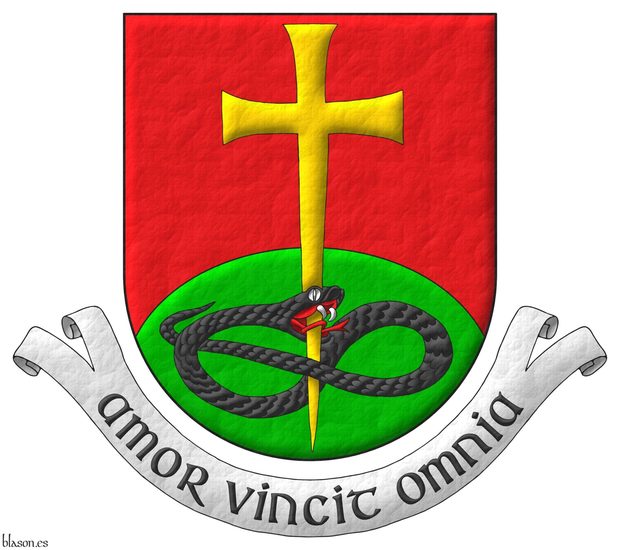
Gules, a base enarched Vert, overall a cross patty fitchy Or, piercing in base the head of a serpent nowed and facing sinister Sable, langued Gules. Motto: «Amor vincit omnia»
Blazon keywords: Without divisions, Gules, One, Mount, Vert, Issuant from base, Overall, Cross patty fitchy, Cross couped, Piercing, Head, Serpent, Nowed, Facing sinister, Sable, Langued and Motto.
Style keywords: Semi-circular, Leather and Outlined in sable.
Classification: Interpreted, Personal and Coat of arms.
Bearer: Grzeszkowiak, Tomasz Arkadiusz.

Nhf, Norsk Heraldisk Forening
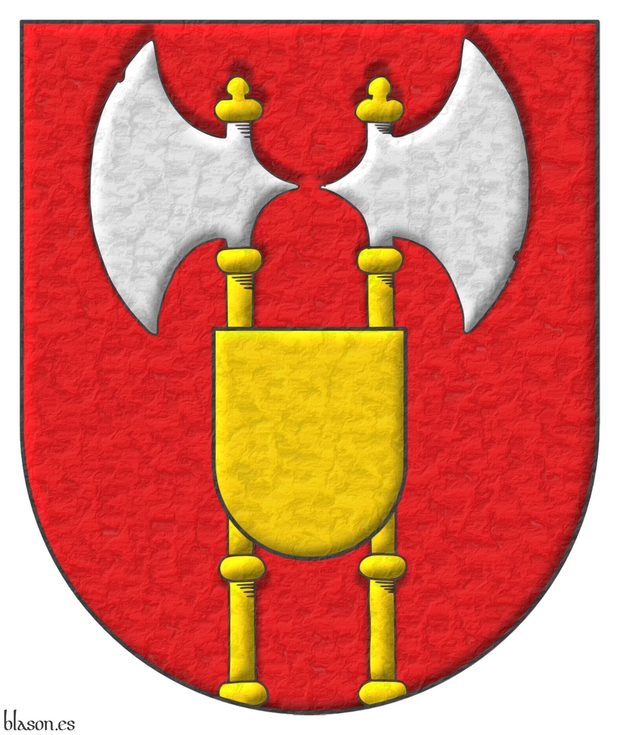
Gules, two Axes Argent, hafted Or, addorsed, issuant from the base; overall, at the nombril, an Escutcheon Or.
Escudo de gules, dos hachas adosadas de plata, fustadas de oro, movientes de la punta; brochante sobre el todo, en el ombligo, un escudete de oro.
Coat of arms interpreted with: the semicircular shape; its field illuminated with Gules; its figures and escutcheon illuminated with Or and Argent and outlined in Sable; and with a free hand texture.
At the nombril
A distinctive feature of this coat of arms is that its escutcheon, instead of being overall in the center, is positioned on a point of the coat of arms called the nombril, which, as we learn from [Avilés, J.; 1725a; page 159 and illustration 19] and also [Avilés, J.; 1780a; pages 147 and 148], in «Heraldry, the nombril of the coat of arms, is the place through which the human body receives nourishment in the mother's womb, and in the shield, it corresponds to the point where the fess ends and the base begins.».
If this escutcheon, «escudete» in Castilian, had been positioned in the center of the coat of arms, then it would have to be blazoned as the piece called an inescutcheon, «escusón» in Castilian. In fact, the Norsk Heraldisk Forening uses the English term «escutcheon» to describe the blazon of its arms.
Blazon keywords: Without divisions, Gules, Axe, Argent, Hafted, Or, Addorsed, Issuant from base, Overall, At the nombril and Escutcheon.
Style keywords: Semi-circular, Illuminated, Outlined in sable, Shaded and Soft metal.
Classification: Interpreted, Socioeconomic and Coat of arms.
Bearer: Norsk Heraldisk Forening.


OpenSea
My heraldic NFTs in OpenSea opensea.io/DrASalmeronHeraldry.
These historical coats of arms, emblazoned by me in order to be minted as unique Non-Fungible Tokens, are only available in this NFT format. By buying them you acquire an unrepeatable signed piece for your collection.
Categories: Technology, Social networks, NFT, Gules, Halberd, Issuant from base and Argent.


Peregrina Corona, Dolores
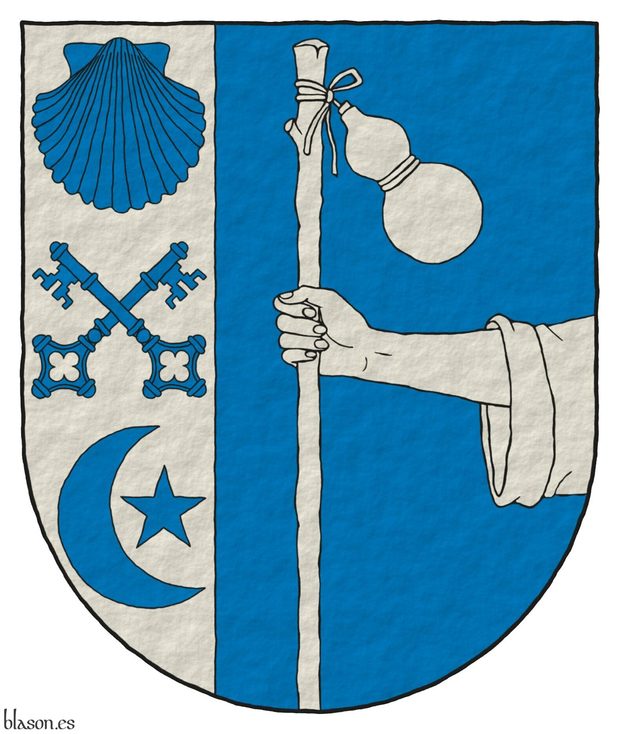
Tierce: 1 Argent, two keys points upwards, in saltire, between in chief an escallop, and in base a mullet of five points environed at dexter by a crescent bendwise azure; 2 Azure, a dexter arm vested, issuant from sinister, grasping a pilgrim's staff palewise, issuant from base, tied to it a gourd bendwise Argent.
Escudo adiestrado: 1o de plata, dos llaves alzadas en sotuer, acompañadas en jefe de una venera, y en punta de una estrella de cinco puntas, circundada a la diestra de un creciente puesto en banda todo de azur; 2o de azur, un brazo diestro vestido, moviente de la siniestra, teniendo un bordón de peregrino puesto en palo, moviente de la punta, y atada a él una calabaza puesta en banda todo de plata.
Arms designed by me, in flat tinctures, contoured in Sable, with a semi-circular outer contour and with a texturized finishing.
Canting arms of Dolores Peregrina Corona designed by Juan Lanzagorta Vallín and me and emblazoned by me. In Castilian heraldic tradition, the «adiestrado» ~ «tierce» used in this coat of arms and its symmetrical «siniestrado» ~ «tierce sinister» are «irregular divisions of the field by one line» ~ «particiones irregulares». That is why I use «tierce» and «tierce sinister» in English. There is another possibility, which is to call the «adiestrado» ~ «pale in dexter flank» and the «siniestrado» ~ «pale in sinister flank», thus ceasing to be a type of «divisions of the field» ~ «particiones» and becoming «ordinaries» ~ «piezas fundamentales». This has implications, as the rule of tinctures would apply if it were considered a «pale» ~ «palo». In any case, I will write the blazon in both ways. Alternative blazon: Azure, a dexter arm vested, issuant from sinister, grasping a pilgrim's staff palewise, issuant from base, tied to it a gourd bendwise; on a pale in dexter flank Argent two keys points upwards, in saltire, between in chief an escallop, and in base a mullet of five points environed at dexter by a crescent bendwise azure.
Design rationale
These are canting arms because her surname is «Peregrina» ~ «pilgrim», and her coat of arms depicts the arm of a pilgrim, as she is one herself, with her staff and her gourd for carrying water, advancing towards the dexter, in order to reach the destination of her three most important life pilgrimages: Santiago de Compostela, Rome, and Jerusalem.
Blazon keywords: Azure, Argent, One, Two, Tierce, Key, Point upwards, In saltire, Between, In chief, Escallop, In base, Mullet, Environed, Dexter, Crescent, Bendwise, Arm, Vested, Issuant from the sinister flank, Grasping, Pilgrim's staff, Palewise, Issuant from base, Tied and Gourd.
Style keywords: Outlined in sable, Plain tincture and Semi-circular.
Classification: Personal, Created, Boa and Coat of arms.
Bearer: Peregrina Corona, Dolores.


Pixiv
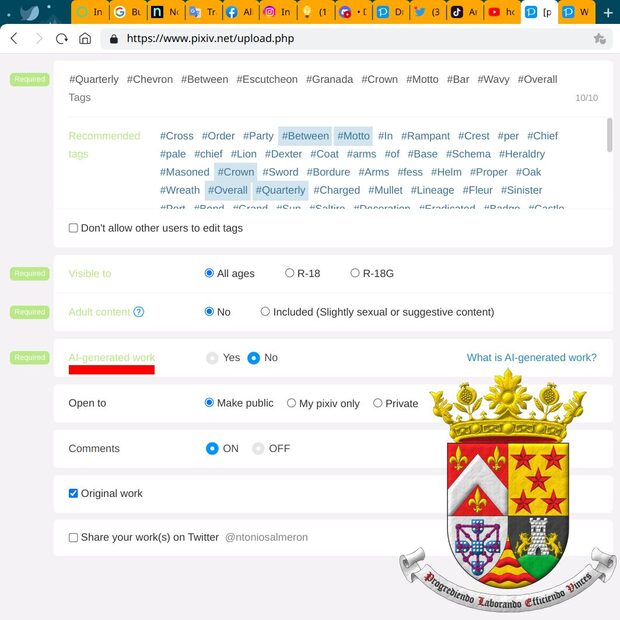
My heraldic Pixiv wall is Dr.A.Salmeron @antoniosheraldry and pixiv.me/antoniosheraldry.
Pixiv is a Japanese online community for artists. I post in Pixiv 2 or 3 coats of arms per week. They use a strict form to post with many mandatory input fields. This week, they have added a new mandatory field «AI-generated work: Yes / No», AI ~ Artificial Intelligence. In the image, I have highlighted this new field in red.
Categories: Technology, Social networks, Quarterly, Gules, One, Chevron, Argent, Between, Three, Fleur de lis, Or, Five, Mullet, In saltire, Four, Escutcheon, In cross, Azure, Charged, Nine, Bezant and plate, Two, Flank, Fesswise, Center, Overall, Carbuncle, Cord, In orle, Knotted, Purpure, Overall (all), Sable, Mount, Issuant from base, Vert, On, Tower, Port and windows, Masoned, Wolf, Supporting, Enté en point, Fess, Wavy, Crown of the Sovereign and Most Noble Order of the Pomegranate, Crown and Motto.


Pons Paneque, Jonathan
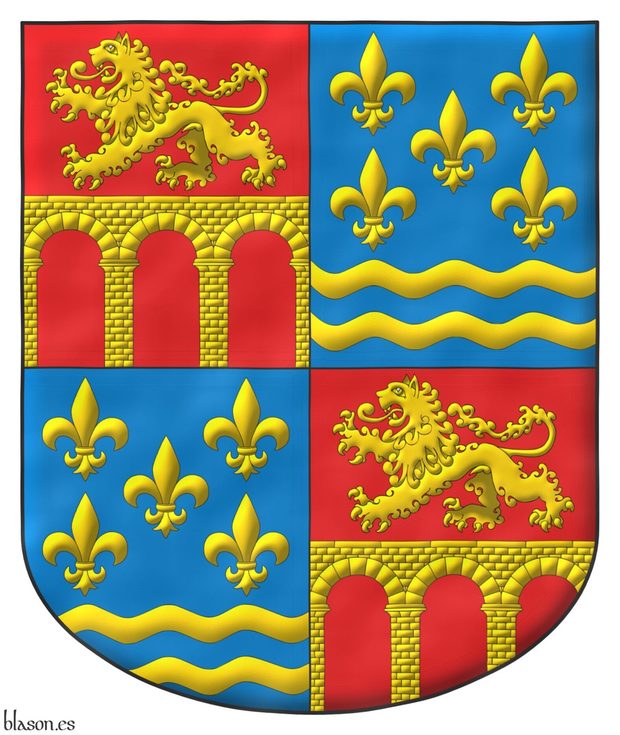
Quarterly: 1 and 4 Gules, a three arch bridge issuant from base and throughout Or; 2 and 3 Azure, five fleurs de lis, in base two bars wavy Or.
Escudo cuartelado: 1o y 4o de gules, un puente de tres ojos moviente de la punta y los flancos de oro; 2o y 3o de azur, cinco flores de lis, en punta dos fajas ondadas, todo de oro.
Coat of arms emblazoned by me with a shape ended with an rounded arch, illuminated, and its finishing is that seems watercolor.
Credits: Felipe Trujillo Jiménez is the designer of the coat of arms and Antonio Salmerón y Cabañas is the author of the heraldic art.
Blazon keywords: Quarterly, Gules, One, Bridge, Issuant from base, Throughout, Or, Azure, Five, Fleur de lis, In base, Two, Fess and Wavy.
Style keywords: Pointed, Outlined in sable, Illuminated and Watercolor.
Classification: Personal, Interpreted and Coat of arms.
Bearer: Pons Paneque, Jonathan.


Rarible
My heraldic NFTs at Rarible rarible.com/blazon.
These historical coats of arms, emblazoned by me in order to be minted as unique Non-Fungible Tokens, are only available in this NFT format. By buying them you acquire an unrepeatable signed piece for your collection.
Categories: Technology, Social networks, NFT, Gules, Halberd, Issuant from base and Argent.
-
Language
-
Categories of heraldry
-
Divisions of the field
- Without divisions
- Party per pale
- Party per fess
- Party per bend
- Party per bend sinister
- Tierce
- Tierce sinister
- Tierced per pale
- Tierced per fess
- Tierced per bend
- Tierced pallwise inverted
- Quarterly
- Quarterly per saltire
- Gyronny
- Party per fess, the chief per pale
- Party per pale, the sinister per fess
- Party per fess, the base per pale
- Party per pale, the dexter per fess
- Chapé
- Chaussé
- Embrassé
- Contre-embrassé
- Party per chevron
- Enté
- Enté en point
- Flanched
-
Metals
-
Colours
-
Furs
-
Other tinctures
-
Ordinaries and sub-ordinaries
-
Diminutives of the ordinaries
-
Geometric charges
-
Composite ordinaries
-
Inanimate charges from Nature
Atom, Crescent, Diamond, Emerald, Estoile, Increscent, Lightning flash, Moon, Mount, Mullet, Mullet of four points, Orbital, Plough of Ursa Major, Rainbow, Ray of the sun, River, Sea, Snowflake, Sun, Sun in splendour, Sun of May, Trimount, Water and Wave.
-
Vegetal charges from Nature
Acorn, Apple, Apple tree, Ash, Bluebonnet, Camellia, Chrysanthemum, Cinquefoil, Cornflower, Dogwood flower, Double rose, Elm, Fleur de lis, Flower, Gourd, Holm oak, Hop cone, Kapok tree, Laurel, Lily, Linden, Lotus flower, Madonna lily, Mexican cedar tree, Oak, Olive tree, Palm tree, Plantain plant, Pomegranate, Poplar leaf, Rose, Shamrock, Sunflower, Thistle, Tree, Tulip, Vine and Wheat.
-
Animal charges from Nature
Badger, Bald eagle, Barbel, Barn owl, Bear, Beaver, Beetle, Bighorn sheep, Blackbird, Boar, Brach hound, Bull, Doe, Dog, Dolphin, Dove, Eagle, Elephant, Falcon, Female figure, Fish, Flame, Fly, Fox, Frog, Goat, Goldfinch, Goose, Heron, Horse, Hummingbird, Jaguar, Lark, Leopard, Lion, Lion passant, Lion rampant guardant, Lioness, Lynx, Male figure, Martlet, Merino ram, Owl, Panther, Parrot, Peacock, Pelican, Pelican in her piety, Puffin, Quetzal, Raven, Roe deer, Rooster, Savage, Seagull, Serpent, She-wolf, Stag, Starling, Talbot, Tyger, Vulture, Warren hound and Wolf.
-
Parts of natural charges
Arm, Beak, Branch, Caboshed, Chest, Claw, Covert, Dorsal fin, Eagle claw, Ermine spot, Escallop, Feather, Foot (palmiped), Foreleg, Forepaw, Hand, Head, Heart, Hoof, Leaf, Neck, Ostrich feather, Palm frond, Paw, Roe deers' attires, Shoulder, Sprig, Stags' attires, Stem, Swallow-tail, Tail, Tail addorsed, Tail fin, Talon, Tooth, Trunk, Trunk (elephant), Two hands clasped, Two wings in vol, Udder, Wheat spike, Wing and Wrist.
-
Artificial charges
Ace of spades, Anchor, Anvil, Arch, Arm vambraced, Armillary sphere, Arrow, Axe, Bell, Bell tower, Beret, Bonfire, Book, Bookmark, Bow, Branding iron, Bridge, Broken, Buckle, Cannon, Cannon dismounted, Cannon port, Canopy roof, Carbuncle, Castle, Celtic Trinity knot, Chain, Chess rooks, Church, Clarion, Clay pot, Closed book, Club, Column, Comb, Compass rose, Conductor's baton, Cord, Covered cup, Crozier, Crucible, Cuffed, Cup, Cyclamor, Dagger, Double vajra, Drum, Ecclesiastical cap, Fanon, Federschwert, Fleam, Four crescents joined millsailwise, Galician granary, Garb, Gauntlet, Geometric solid, Grenade, Halberd, Hammer, Harp, Host, Hourglass, Key, Key ward, Knight, Knot, Lantern, Letter, Line, Loincloth, Menorah, Millrind, Millstone, Millwheel, Monstrance, Mortar, Mullet of six points pierced, Nail, Non-classic artifact, Norman ship, Number, Oar, Oil lamp, Open book, Page, Pair of scales, Parchment, Pestle, Piano, Pilgrim's staff, Plough share, Polish winged hussar, Port, Portcullis, Potent, Quill, Ribbon, Rosette of acanthus leaves, Sabre, Sackbut, Sail, Scroll, Scythe, Sheaf of tobacco, Ship, Skirt, Spear, Spear's head, Stairway, Star of David, Step, Sword, Symbol, Tetrahedron, Torch, Tower, Trident, Trumpet, Turret, Two-handed sword, Wagon-wheel, Water-bouget, Wheel, Winnowing fan and With a turret.
-
Immaterial charges
Angel, Archangel, Basilisk, Dragon, Dragon's head, Garuda, Golden fleece, Griffin, Heart enflamed, Justice, Mermaid, Our Lady of Mercy, Ouroboros, Paschal lamb, Pegasus, Phoenix, Sacred Heart of Jesus, Saint George, Sea-griffin, Trinity, Triton, Unicorn, Winged hand and Wyvern.
-
External elements
-
Heraldic creations
-
References
-
Formats
-
Keywords on this page
Port and windows, Between, Watercolor, Proper, Halberd, Facing sinister, Pointed, Azure, Boa, Overall, Head, Charged, Five, Ogee, Created, Cross couped, Quarterly, Four, Outlined in sable, Two, In chief, In base, In saltire, Escutcheon, Coat of arms, Mullet, Fess, Scroll, Flank, Fleur de lis, Personal, Gules, Illuminated, Interpreted, Langued, Motto, Lineage, Semi-circular, Mount, Trimount, Issuant from base, Or, Argent, Social networks, Sable, On, Technology, Freehand and One.

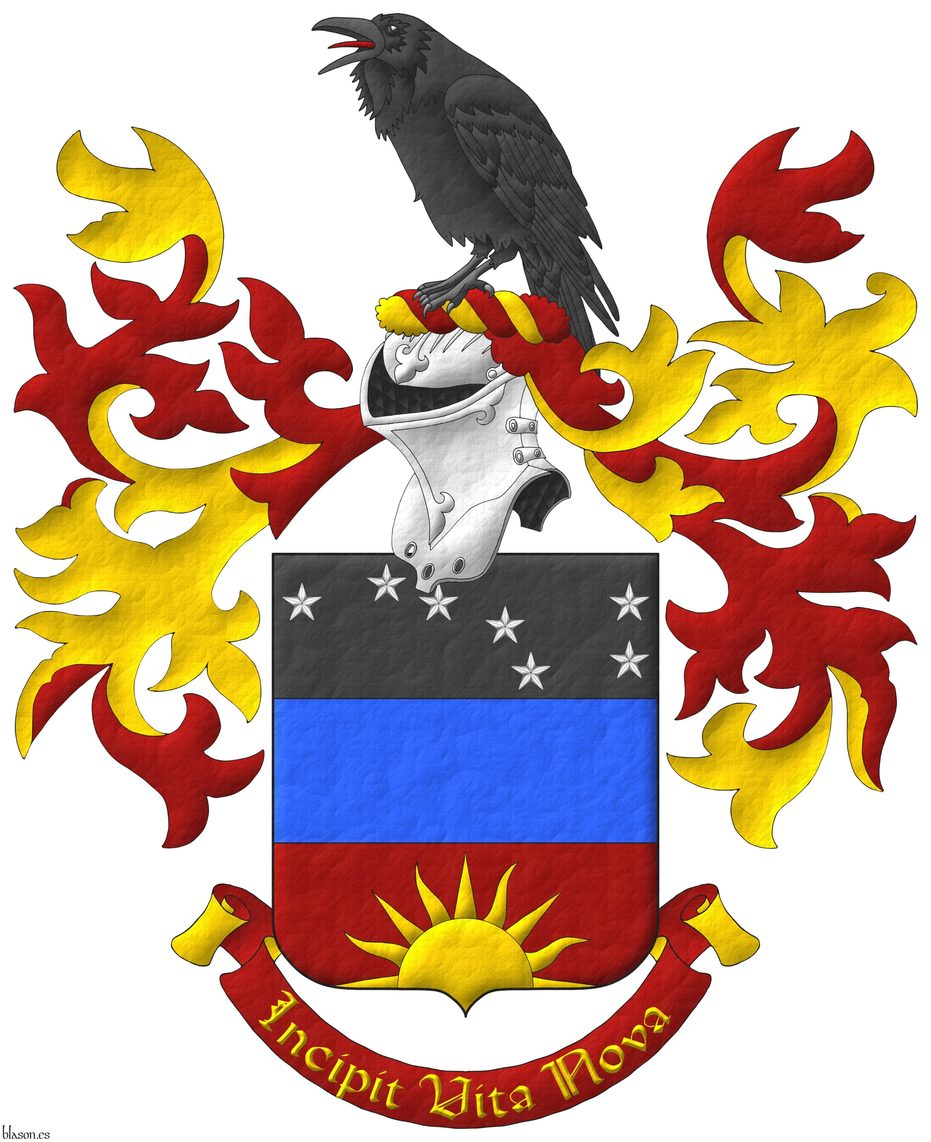
![Ignasi Pujol, comparation [ Azure, a mount issuant from the base, in chief a fleur the lis Argent ] and [ Party per chevron Azure and Or, in chief a fleur de lis Argent, in base four pallets Gules ].](../escudo_armas/PujolIgnasi.20.PujolLineage.Ogee.Compare.jpg)
